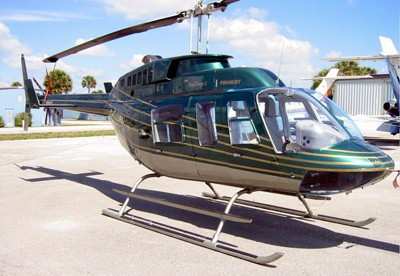Tue, Dec 10, 2019
Inspections Find Possible Fuselage Cracking And Loose Rivets
The FAA has released a Special Airworthiness Information Bulletin (SAIB) following reports of fuselage cracking and possible loose rivets on Bell Model 206L helicopters in an area that currently has no inspection program.

There are multiple reports of cracks found in the fuselage frame/bulkhead of Bell Model 206L helicopters upper area of fuselage station (FS) 145.
The FAA’s Monitor Safety/Analyze Data (MSAD) data contains several reports documenting cracks found in stiffener Part Number 206-033-107-055. The stiffener is located in the upper area of FS 142.7 where the aft cabin bulkhead and the bulkhead for the aft passenger seat come together. Further investigation, including reports from the Service Difficulty Report (SDR) database, revealed additional occurrences of cracks in the area of FS 145. The reported cracks were found by visual inspection and were not limited exclusively to the stiffener. This area can be highly loaded and could be subjected to movement. As a result of the movement, it is not uncommon to find the rivets in this area “smoking” or working and in need of replacement. Over time, the loose rivets could result in cracking of the fuselage structure.
During parts of the progressive inspection, opening of the door assemblies is required to inspect the most aft hardware of the pylon support assemblies for the transmission and the forward engine mount fuselage structure. However, there are currently no specific Service Bulletins or Notices to inspect this area. Access to conduct a thorough inspection can also be limited by the size of the opening. The Bell 206L Maintenance Manual and Structural Repair Manual do not include specific damage assessment criteria or repairs for this area. Transport Canada has issued Civil Aviation Safety Alerts (CASA) No. 2019-05 to raise awareness of a potential crack in the fuselage frame/bulkhead going undetected during a scheduled maintenance inspection. The CASA is available here.
The FAA recommends the following for all Bell Model 206L series helicopters:
Each time the left and right hand door assemblies of this SAIB are removed, inspect the entire internal structure of FS 142.7 to FS 155.00 for smoking and working rivets and for cracks. For areas with limited access, the use of a mirror and flashlight as an aid in the visual inspection is recommended. A borescope could also be used.
Use the approved Bell Maintenance and Structural Repair Manuals (SRM) for inspecting, repairing and replacing defective parts that are within the scope of authorized maintenance.
For any repairs not included in the SRM, repair in accordance with any FAA approved repair. The FAA will continue to monitor MSAD (SDR) related to this issue and may issue recommended or mandatory corrective action, if necessary.
(Source: FAA. Image from file)
More News
The Industry Continues to be Rocked By Some Questionable Operations Recent investigations and a great deal of data has resulted in ANN’s SportPlane Resource Guide’s rep>[...]
Make Sure You NEVER Miss A New Story From Aero-News Network Do you ever feel like you never see posts from a certain person or page on Facebook or Instagram? Here’s how you c>[...]
Visual Approach Slope Indicator (VASI) An airport lighting facility providing vertical visual approach slope guidance to aircraft during approach to landing by radiating a directio>[...]
Airport Marking Aids Markings used on runway and taxiway surfaces to identify a specific runway, a runway threshold, a centerline, a hold line, etc. A runway should be marked in ac>[...]
Aero Linx: The Skyhawk Association The Skyhawk Association is a non-profit organization founded by former Skyhawk Pilots which is open to anyone with an affinity for the A-4 Skyhaw>[...]
 Unfortunate... ANN/SportPlane Resource Guide Adds To Cautionary Advisories
Unfortunate... ANN/SportPlane Resource Guide Adds To Cautionary Advisories ANN FAQ: Turn On Post Notifications
ANN FAQ: Turn On Post Notifications ANN's Daily Aero-Term (04.29.24): Visual Approach Slope Indicator (VASI)
ANN's Daily Aero-Term (04.29.24): Visual Approach Slope Indicator (VASI) ANN's Daily Aero-Term (04.28.24): Airport Marking Aids
ANN's Daily Aero-Term (04.28.24): Airport Marking Aids ANN's Daily Aero-Linx (04.28.24)
ANN's Daily Aero-Linx (04.28.24)



